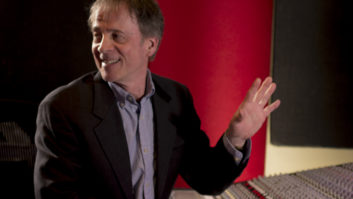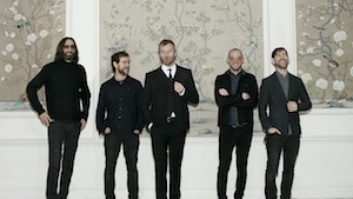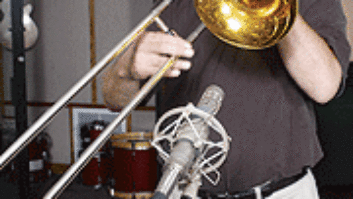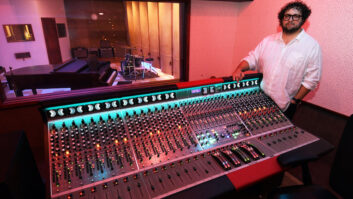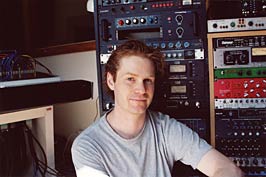
Adam Lasus has a comfortable gig in his new West Coast studio space.
When rent on his Brooklyn, N.Y., studio, Fireproof Recording, jumped from $1,000 a month to nearly quadruple that amount, producer/engineer Adam Lasus faced a difficult decision: go against his philosophy of offering affordable recording to D.I.Y. and indie bands, or move out of the converted 1800s firehouse. Having produced and/or engineered albums for Madder Rose, Helium, Gigolo Aunts and, more recently, Brooklyn-based indie darlings Clap Your Hands Say Yeah, he chose to relocate — all the way to the other coast in Studio City, Calif.
“It was the classic scenario,” says Lasus from his new operation, which opened in early 2006. “My wife, Linda, and I realized that for the same money we were paying on rent for our tiny New York apartment, her office and my studio, we could buy a house with a yard and space for a studio.” They chose the L.A. area to be near Lasus’ in-laws, which meant grandma could help babysit their newborn son.
They found a home that serendipitously included a separate 600-square-foot building that the previous owner had used as a soundproofed rehearsal space, with cathedral ceilings and nonparallel walls. Getting the space studio-ready required very little construction. Lasus hired a contractor to install windows for an iso room and control room and filled a hollow wall with Fiberglas. “We had to do some sonic treatment with foam, but because it’s built on concrete, the place sounds fantastic,” says Lasus, who did much of the design work on his Brooklyn studio.

Lasus brought most of his equipment from Fireproof-East, including a 32-channel Neotek Elan (he first worked on one at Fort Apache Studios in Boston, where he engineered albums for Juliana Hatfield, among others) and an Otari MX-80 24-track machine, which he almost always uses to record basic tracks “until the tape is full, then I transfer over to [MOTU] Digital Performer,” he says. For outboard, he favors his Chandler Limited, Wunder Audio and Brent Averill 312A mic pre’s, UREI 1176, Focusrite Red, Allison Research Gain Brain and Manley ELOP compressor/limiters, as well as “quirky” items such as a Maestro Echoplex tape delay, a Roland RE-150 Space Echo, and Audio Design Recording’s Vocal Stressor compressor and Compex limiter. Though he incorporates various plug-ins and uses Digital Performer for automation, he usually mixes by going back through the Neotek and outboard gear down to a Studer A80 ½-inch 2-track, “making records that sound like the ones we grew up on,” he says.
To make guests feel at home, he vibes out his space with comfortable furniture, lava lamps and an assortment of instruments, including a drum kit, a Moog synth and Casio keyboards, guitars, amps and pedals, and a Mattel Optigan, a nifty toy keyboard that comes with disks filled with ’70s-era drum, guitar and piano samples. Jon Brion, Tom Waits and Blur have used the Optigan on various projects.
Though Lasus found an ideal space in L.A., he built his niche in New York and had some trepidation about relocating. Well, he barely had the truck unloaded when Clap Your Hands Say Yeah’s self-titled release — recorded in two weeks at his Brooklyn studio — hit big, ultimately selling more than 200,000 copies worldwide (with no record deal), landing a slot on Rolling Stone‘s Hot List, and getting airplay on L.A. powerhouse radio stations such as KCRW and Indie 103.1 FM. As soon as L.A.’s indie scene found out that the CYHSY producer lived and worked nearby, Lasus received a wave of new clients from around town, as well as bands from throughout the U.S. and as far off as Germany and the UK.
He recently finished tracking an album with singer/songwriter and former Varnaline front man Anders Parker, backed by the exceptional lineup of drummer Ken Coomer (Wilco), pedal steel player Eric Heywood (Son Volt, The Jayhawks), bassist Jennifer Condos (Jackson Browne) and guitarist Kirk Swan (Dumptruck, Steve Wynn, John Wesley Harding). With the exception of Parker and Heywood, who recorded in the iso room, the band recorded in the control room. “It’s my biggest room,” says Lasus, who also recorded Varnaline’s self-titled album. “Ken Coomer was 20 feet away, backed up against the wall so that I could use room mics. The bass player and guitarist were a couple feet from me, so it was sort of a fun, cozy vibe. You feel like you’re more a part of the session instead of someone that’s looking at it from between the speakers.”
Now that the L.A. community is starting to embrace its latest East Coast import, Lasus can pick up where he left off in his once-affordable Brooklyn neighborhood. Clap Your Hands — and roll tape.
Heather Johnson is a Mix contributing editor.
